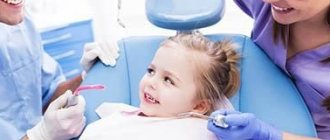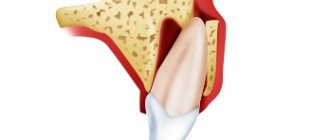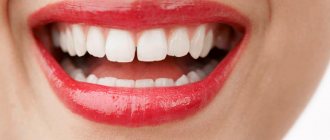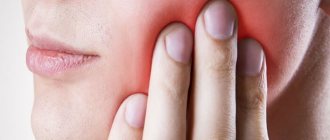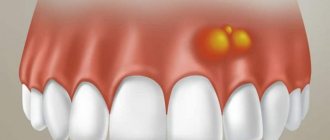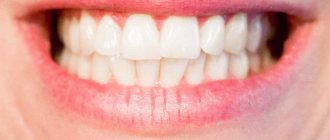Milk teeth are bone formations that are designed for mechanical processing of food in order to prepare it for subsequent digestion. They also influence diction and make the child’s speech correct and clear. In terms of their anatomical structure, they are in many ways similar to permanent ones, but they all have some differences. Among them:
- the coronal part is smaller;
- the thickness of enamel and dentin is less (from 0.6 to 1 mm);
- reduced degree of mineralization;
- no immune zones;
- the pulp volume is large;
- dental canals are shorter;
- poorly developed tubercles in the closure zone.
As for the number of root canals, their number remains unchanged.
The roots of baby teeth are slightly inclined. This is explained by the fact that the rudiments of permanent units are located above them.
It is a mistake to believe that children's teeth do not have roots. But this is what many adults think when they look at their children’s fallen teeth. In fact, by the time of prolapse, the formations located in the alveoli are almost completely resolved.
Home methods for removing baby teeth are not always safe
The most common way to forcibly pull out loose baby teeth at home is with a thread tied to the tooth and wound around the door handle. Some “lucky” readers probably went through this procedure in childhood and remember how unpleasant it was. Home methods for pulling teeth are not always safe. Such removal can provoke the development of infection or inflammation of the socket of the extracted tooth, which requires serious treatment. Find out what to do if the hole becomes rotten after tooth extraction.
Using improvised means, you can remove a baby tooth at home only if it is literally “hanging by a thread.” But in order not to cause psychological trauma to the child, this procedure must be made into a game.
How to protect baby teeth from caries?
Prevention is the best way to cope with any disease. Therefore, those parents who care about the health of their children should definitely think about caries prevention. How to protect baby teeth from caries? The recommendations of experts in this matter are as follows:
- The correct diet for the mother during pregnancy is with a sufficient amount of foods containing calcium, fluorine and phosphorus: cottage cheese, beef and beef liver, sea fish, nuts, fruits and vegetables, cereal porridges.
- Compliance with hygiene standards: daily brushing from the moment the first teeth appear, first with a cotton or gauze swab with boiled water, then with special baby brushes and pastes. Plaque on baby teeth should be removed promptly and thoroughly.
- A healthy diet for a child: as little fast carbohydrates, carbonated drinks, sweets as possible, more fruits and vegetables, cereals, and dairy products.
- Timely visits to the dentist for preventive examinations (at least once every six months).
It is important that parents develop a conscious attitude towards the health of their children's teeth and oral cavity in general. A timely visit to the dentist in case of any identified problems, as well as for regular medical examinations, will help maintain the health of the child’s dental system – and therefore the digestive system too.
Little Mouse VS Tooth Fairy
Loss of baby teeth in children is associated with rituals in different countries. In Russia, back in ancient times (since the 18th century), there was a belief that a lost tooth should be put in the hole of a mouse and in return ask it for a permanent one, which will be healthy and durable.
In the West, instead of a mouse, the Tooth Fairy is popular, which exchanges a baby tooth placed under the pillow for money. This is precisely the reason why children in Russia nowadays prefer to “cooperate” with her.
Gum inflammation
The most common inflammatory gum diseases in children are stomatitis and gingivitis. Stomatitis, or, as it is usually called, thrush, is an infectious inflammatory process provoked by fungi of the genus Candida. Treatment is antifungal and anti-inflammatory therapy, always carried out under the supervision and recommendations of a dentist. Self-medication can be dangerous, as some children may have allergic reactions to certain medications or antiseptics.
Gingivitis most often occurs due to plaque on baby teeth and insufficient general hygiene, but the reasons for their development can also be trauma to the gums during teething or other injuries, untreated caries. With this problem, you also need to contact a doctor, who will select the optimal treatment regimen and prevent gingivitis from developing into childhood periodontitis.
In the future, people will not have wisdom teeth
It is now recognized that wisdom teeth are vestigial. This is the most problematic group of teeth, with many painful moments associated with it. When they erupt, a person may experience severe pain, inflammation, fever, and when all wisdom teeth appear, crowding of the dentition may begin. At the same time, they play almost no role in the process of experiencing food. Evolutionary changes lead to the fact that in modern times, wisdom teeth are increasingly not erupting in adults. It can be assumed that in the future they will disappear altogether.
Why is it important to treat baby teeth?
Now that it is clear that the structure of baby teeth is very similar to permanent teeth, the question “To treat them or not to treat them” should not arise for parents at all. Advanced caries often leads to destruction and damage to the pulp. Then the roots become involved in the pathological process. Removing dental nerves is not a pleasant procedure. It is important to prevent its occurrence.
Moreover, refusal of dental treatment can result in a number of other problems. This means:
- Incorrect bite formation. If, due to the destruction of the crown, the doctor has to remove it ahead of time, voids appear in the row, which “neighbors” tend to occupy. Then, by the time the “adult” unit erupts, there may not be a place for it - it will begin to grow somewhere on the side and ruin the smile.
- Damage to future teeth even before they erupt. With deep caries and periodontitis, cysts often form. They affect the rudiments of permanent teeth. Then the child is faced with the fact that his new tooth turns out to be sick and requires urgent treatment. Needless to say, its service life will be significantly reduced because of this.
- Diseases of the gastrointestinal tract. If parents believe that it is better to remove baby teeth rather than treat them, then by the age of nine their child (especially if he is prone to developing dental diseases) may lose half of his teeth. Is it possible to fully chew food in such a situation? No. The child regularly swallows poorly chewed foods. Because of this, the load on the intestines increases, which can result in frequent abdominal pain, stool disorders, nausea, gastritis and more serious gastrointestinal diseases.
- Psychological complexes. At 9-10 years old, a child evaluates his appearance and sees that his smile is very different from the smiles of his peers - it does not have a large number of teeth or they are dark in color, half destroyed. Because of this, he begins to be embarrassed to smile, laugh, and tries to talk less. All this negatively affects his self-esteem and does not allow him to quickly adapt to new situations and successfully go through the process of socialization in elementary school.
Don't waste your children's teeth. Teach your child from childhood to undergo preventive examinations in the pediatric dentistry department. At the same time, choose a specialist for him who you can trust. Then the child will not perceive another visit to the dentist as something terrible. He will be happy to go to the appointment, knowing that he will not be hurt.
What to do after a child’s tooth extraction?
- Make sure that the child spits out the tampon that was placed after removal after 15-20 minutes.
- After removal, a blood clot should remain in the hole, which protects it from inflammation. There is no need to clean the hole from blood, rinse the mouth, the child should not touch the removal site with hands or objects.
- If the child has been given anesthesia, explain to the child that he should not bite on the numb side until the feeling of cold and pins and needles goes away.
- Feed your baby only warm, soft food for several days.
- Maintain good hygiene; brushing your teeth is not only possible, but also necessary, with a soft toothbrush, carefully avoiding the extraction site.
- If the tooth extraction was difficult, then try to limit the child’s physical activity so as not to provoke bleeding.
Treat caries or remove a tooth?
Here, the recommendations of pediatric dentists agree: teeth need to be treated, although this is often associated with inconvenience. True, it is now much easier to persuade a child to calmly undergo treatment than it was before, when quality dentistry was unavailable. In a modern clinic, a calm and friendly atmosphere is important in a pediatric dentist's office. The doctor will first show the instruments, explain what he will do, and establish contact with the child. And drugs for pain relief will help carry out the treatment so that there are no negative impressions left from it.
Dental treatment is not scary! Especially if it doesn't hurt
It is best to treat tooth decay in its early stages. Then you can do without drilling at all - it will be enough to clean the surface of the tooth and apply a remineralizing composition. Small areas of caries can also be treated using a special device that uses a laser beam.
But even if a large carious cavity has already formed in the tooth, it is still recommended to install a filling. In some cases, crowns are even placed to save the tooth, which will last until the tooth falls out naturally. All this is justified in order to preserve the functionality of the tooth, which is extremely important for the formation of a correct permanent bite in a child.
Crowns can be installed to save teeth
What are the anatomical features of “children’s” molars?
- The first upper molars are smaller in size than the second ones. The first has two widely spaced roots, which sometimes merge to the apex. The rudiment of the first “adult” premolar is formed between the roots. Most often, the first upper molars have four root canals, although there are also three or two (in 19 and 5% of cases, respectively).
- The first lower molars differ from others by having an elongated prismatic crown. On their chewing surface there are four tubercles: lingual, higher, and buccal. The first “children’s” molar has 2 roots, with the medial one being longer and wider than the distal one. Often the first lower molars have three canals.
- The structure of the crown of the second upper molars of the dentition resembles the first upper permanent tooth. Four tubercles are clearly visible on the surface, and sometimes a fifth one is noticeable. The buccal surface is almost square with slightly convex sides. An enamel ridge is often visible on the palatal side. Such teeth have three roots, in 85% of cases there are 4 root canals, much less often - 3.
- The second lower molars already have five cusps with less deep grooves than those of “adult” teeth. Both roots are flattened and curved at the top. In 85% of cases, teeth have three canals, although there are exceptions.
With the eruption of permanent, “adult” molars, the change of teeth begins, which lasts from 5-7 to 12-14 years. It is the first molars, which do not have primary analogues, that hold the bite, ensuring the correct placement of the remaining permanent teeth in the arch.
How temporary teeth are removed
Like any other medical procedure, tooth extraction has a clearly developed scheme and is carried out in several stages:
- Local anesthesia is the most common form of anesthesia. Specialists turn to more serious methods (general anesthesia) only in extreme cases: pathologies of the child’s psyche, purulent processes in the oral cavity, an allergic reaction and a history of individual intolerance to local anesthetics;
- Application of forceps to the crown;
- Rocking baby tooth;
- Its removal from the hole;
- Removal of fragments and granulations remaining in the socket;
- Packing the wound surface.
In order for both the doctor and the little patient to feel comfortable, parents must prepare the child and explain to him the importance of this procedure. Mental preparation is an important aspect of treatment.
How to go to the dentist, remove a baby tooth and not scare your baby?
It is recommended that a child’s baby teeth be removed by pediatric dentists: it will be painless, safe and timely. For everything to go smoothly, a visit to the dentist should be associated with something pleasant and calm. Modern dentistry has a friendly atmosphere, new painkillers have appeared, and instruments (especially in children's offices) do not inspire fear.
Finally, our advice: don’t worry and don’t let your child worry. The calmer you are about going to the dentist, the calmer your baby will behave. Stay nearby in the dentist's office, because parental support is extremely important to him.
Possible treatment options
The method of preserving a damaged baby tooth depends on the degree of damage. Sometimes the dentist suggests taking an x-ray to diagnose damage to adjacent crowns, tooth dislocation and assess the condition of surrounding tissues. Before restoring a tooth, the dentist performs hygienic treatment of the oral cavity.
Treatment methods for a chipped baby tooth
- Enamel chipped - polishing the sharp edges of the crown.
- A baby tooth has broken off within the dentin - building it up with photocomposite material or covering the chip with a crown fragment.
- Fracture exposing the dental nerve - reconstruction using a tooth fragment.
- Mobility, displacement of teeth - applying a splint to the damaged tooth and two adjacent crowns (one on the right and on the left) under local anesthesia.
- A child has a cracked baby tooth in the root zone - sealing the damage and strengthening the crown with an onlay.
Thanks to the precise selection of the color of the composite material, the restored baby tooth does not differ from healthy crowns. The child will not experience psychological discomfort, but the teeth must be treated with care to avoid repeated chipping.

